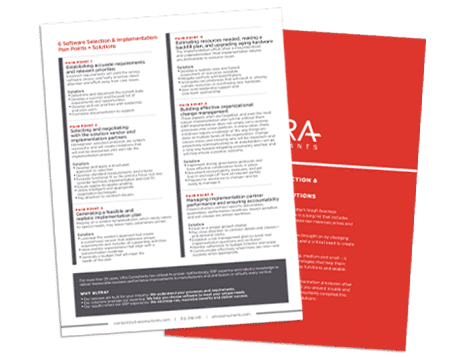In the work our independent ERP consultant team does out in the field, we understand that smart manufacturing demands the smart use of data.
That’s the focus of the Smart Manufacturing track of presentations, taking place at FABTECH 2018 on Tuesday, November 6 at the Atlanta Convention Center. I am joining Epicor and other thought leaders for timely sessions on how to drive value and transformation in the world of connected manufacturing and the Industrial Internet of Things.
In advance of the event, this post previews the topic of smart manufacturing to drive business process transformation.

Some Definitions
Digital Transformation: We can think of the concept “Digital Transformation” as the process of optimizing technology to improve performance and drive value for customers and employees to more effectively compete in an ever-changing digital economy.
With disruptions from technological advancements such as the Industrial Internet of Things (IIoT), manufacturing organizations must work toward digital transformation, using real-time data to make decisions quickly, to mine for actionable intelligence, and to create a competitive advantage.
The Industrial Internet of Things: The Industrial Internet of Things can be thought of as manufacturing or distribution related hardware and software that work together through internet-of-things-style connectivity to track and enhance manufacturing and industrial processes. Like the tightly linked data connectivity that makes up the Internet of Things, the Industrial Internet of Things is all about optimizing operational efficiency and automation, with IT systems such as Enterprise Resource Planning (ERP) as a key driver. Innovations in connected manufacturing, sensors, machine learning, and other areas transform operations, and demand new levels of data integration.
Lights Out Manufacturing: More of a metaphor than a literal description, “lights out manufacturing” is an automatic factory which operates without the need for human workers. The “lights out” idea refers to the fact that one could turn out the lights and other utilities, leave the factory, and allow machines to keep working. In theory, automatic factories save money by increasing production and making the most of floor space.
Data Integration is Key
When machines, sensors, production tracking, process tracking and other initiatives, such as “Lights Out Manufacturing” automate operations, integrated data availability is critical to success.
Ready access to business intelligence will have a significant impact on forecasting, inventory control and customer service. Linking manufacturing devices to input production data, such as product counts, temperature variables, quality output tracking and alerts, is one area where manufacturers could reap immense rewards.
Imagine a scenario where the product is exchanging data over the internet, enabling the manufacturer to monitor for usage and wear and tear and anticipate needed maintenance without an equipment failure or disruption in business continuity.
In another scenario, think of how the forecasting process, which in the past has been an inexact, time-consuming and imperfect process, can be eliminated by communicating point-of-sale inventory information directly to the manufacturer. This exchange of information would allow the manufacturer to transition from the make-to-stock production model to the more profitable make-to-order model. The manufacturer could focus on only producing the in-demand products, resulting in less need for slow-moving inventory.
Business intelligence which once relied on historical transaction data to support decision making now becomes a tool to reveal the present reality and improve decision making.
With the smart manufacturing era’s greater reliance on data integration and connected technology, security implications are of utmost importance.
It’s essential to ensure that IIoT data is secure and available to senior managers and only those individuals closest to the machine sensors on the shop floor. Data integrity and security require strategies to mitigate risks and safeguard data.
The Goal – Business Process Improvement
Ultimately, what’s key in smart manufacturing is the use of integrated data in the context of overall business processes, which requires tighter integration with IT applications like ERP.
The industrial Internet of Things, when fully realized, has the potential to deliver cost savings and a competitive differentiator to those technology adopters wise enough to grasp its potential. Slow adopting manufacturers will end up at a disadvantage.
As an ERP consulting firm serving manufacturing and distribution teams, we’re committed to staying at the forefront of industry trends.
Contact Ultra Consultants to start your technology-enabled transformation.
Attend the Session:
During my Smart Manufacturing session during FABTECH 2018 on Tuesday, Nov. 6 2018, we’ll summarize cases where it’s possible to issue work orders automatically when sensors track production and process monitoring in real time.
We’ll also discuss process monitoring for maintenance. This level of automated data integration can enable scheduling of the appropriate technicians and adjust production schedules based on fault reports and overall equipment calculations.
6 Software Selection & Implementation Pain Points + Solutions
Software selection and implementation processes often present challenges of their own. To steer you around trouble and help you drive success, Ultra’s experts compiled a list of pain points and solutions to be aware of as you embark on this journey.
Table of Contents
More ERP material...
Smart Hospitals Start with Smart Systems: Why Modern Healthcare ERP is Critical
Data analytics holds the ability to highlight inefficient manufacturing processes and enable…
Selecting the Right TMS System: Key TMS Features and Trends to Consider
Data analytics holds the ability to highlight inefficient manufacturing processes and enable…
Choosing a CRM System for Your Business
Data analytics holds the ability to highlight inefficient manufacturing processes and enable…




